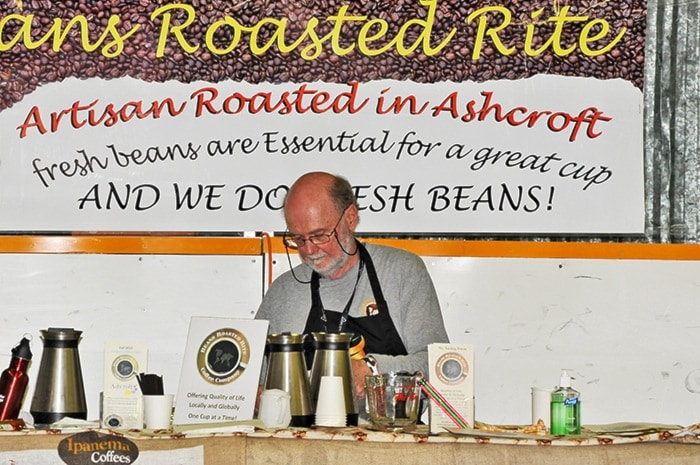It should be any coffee lover’s dream - the business of roasting and studying and selling coffee.
It wasn’t on David Durksen’s bucket list, by any means. In fact, he didn’t even drink coffee, having lost his senses of taste and smell in an industrial accident when he was a teenager.
His wife, Alice, however, loves her coffee.
“When we moved up here, Alice was used to Bean Around the World in Victoria,” he says.
None of the local roasters produced a coffee that was good enough for her, he says, not even the Kamloops roasters.
Then he met Ed Van Thienen at the Christmas Craft Fair in Cache Creek. Ed had been roasting beans on a small commercial scale for about three years, but health issues were making it hard for him to keep roasting. He wanted to sell.
Durksen offered to help Ed roast a batch and ended up spending a month and a half learning how to roast. He bought Ed’s equipment and stock in 2008.
That was all it took for him to become immersed in the world of coffee roasting. He joined the roasters’ guild, took courses and started becoming passionate about it. “You go, ‘Oh my God, this is really what coffee is all about’.”
Each year the roasters guild holds a retreat in coffee country. In 2009 they held it in Panama and Durksen attended.
The retreat was full of lectures and workshops, but he remembers that at one point, they were divided into teams and given beans to roast on three different roasters. Panamanian Geisha. At one time very rare. Still very expensive.
Durksen says he has always favoured a light to medium roast. “Since I’ve started,” he says, “the whole coffee movement has gone from dark to light roast because there’s more flavour and nuance.”
He managed to pull off a 96.7 point score from the experts on his coffee. Only one other long-time roaster got a higher score - 96.8.
The business is still similar to what he bought from Ed. He purchases 15 different beans through Organic Products Trading Company, a Washington-based company that works directly with small-scale farmers around the world to source high quality green specialty coffee.
“I know what’s happening at the farms,” he says, “How the seasonal workers are treated. The rust problem in Central America.”
In 2010 he visited 17 Brazilian coffee co-operatives with a group of other roasters.
He says he was looking at some unique looking beans when a small, elderly lady came running towards him, gesturing wildly and speaking a mile a minute in Portugese. He had no idea what she was saying.
His host came over and translated her message. She wanted to thank him for buying the coffee that she picked. Because of him and other buyers, she receives a good wage and her grandchildren come to the co-operative on weekends for computer training. And because of that, they’ve been selected to attend university.
He says that the Nicaraguan co-operative they buy from uses part of their profits to send children of their workers to the US for training in education and medicine.
“It’s little things like that really improves the quality of life for others,” says Durksen.
Ninety per cent of the world’s coffee production takes place in developing countries, while coffee consumption takes place in industrialized nations.
Cafe Femenino was started in 2004, a collaboration between Organic Products Trading Company (OPTCO) and CECANOP, a Peruvian coffee co-operative. The Cafe Femenino program assist female farmers, using the production and sale of their own product as the vehicle to create social change in coffee regions.
“Coffee is incredibly political,” says Durksen.
Coffee traceability has become a big issue. In politically unstable regions, the isolated co-operatives are sometimes overwhelmed by paramilitary forces who want them to plough under the coffee plantation in order to grow drug crops. If they refuse, they’re killed. If they comply, they’re put in prison. In other countries, the government uses a large portion of the money from coffee sales to finance their army.
Coffee exporting is a $20 billion industry; coffee farms provide the economic livelihood of over 25 million people.
Boycotts by large fair trade buying groups such as OPTCO make a big difference in the economy of developing countries and ensure better treatment for the workers. Coffee traceability means buyers can trace their money they spend on beans right back to the growers.
Durksens says he’s hoping to get back into roasting chocolate this winter. But first, there’s some equipment he needs to buy.
Two years ago at the Rotary Club’s annual wine-tasting, Durksen offered his fresh coffee and three samples of chocolate. He says he thinks he’s found seven really unique varieties to roast.
He says he went to Vancouver one year with Alice, who was an Ashcroft Councillor at that time. While she attended her conference, he remained in his room, doing a little roasting while listening to a CBC interview with a lady from East Van Roasters who talked about coffee and chocolate. He had to go pay them a visit.
East Van Roasters is set up in the Ranier Hotel in East Vancouver. The hotel houses marginalized women with addictions. EV Roasters provides the women with work and job skills. Durksen says their chocolate is exceptional.
Chocolate beans are sourced the same way that coffee beans are, he says. But the roasting is totally different.
With coffee, says Durksen, you’re taking the beans through a heat curve, slowly raising the heat of the roaster and then lowering it. With chocolate, you’re taking it to a temperature and holding it, then cooling it quickly.
